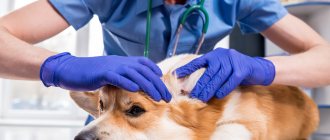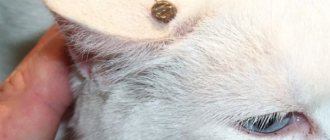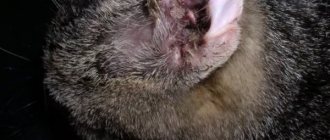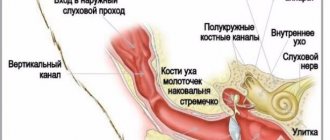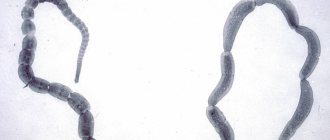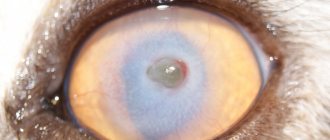Author:
Savina Elizaveta Sergeevna
therapist, surgeon, dermatologist, work with small rodents and rabbits
Ear mites (Otodectosis) are a problem not only for homeless and street animals, but also for completely healthy pets. Most cat owners experience this disease, but this disease is by no means uncommon in dogs. The consequence of this pathology is otitis media in animals.
Few people know how to treat it, much less how to detect it. Often, owners think that the animal has simply dirty its ears, since, apart from constant itching, this disease has no more characteristic and noticeable symptoms, and increased secretion of wax is mistaken for ordinary dirt.
The causative agent of the disease
The causative agent is O. cynotis - a scabies mite-carpet beetle of oval, tortoise-shaped shape, off-white color, with a brown tint in places with stronger chitinization. The head, chest and abdomen are fused into one whole. The proboscis is located on the front of the body. Females are much larger than males. The size of females is 0.32-0.75 mm, males 0.2-0.6 mm. In females, the posterior end is rounded, and in males it is equipped with two abdominal processes with a tuft of setae on each. There are four pairs of legs on the ventral side of the tick. Each leg consists of five segments (coxa, trochanter, femur, tibia, tarsus). At the tops of the tarsi there is a soft membranous pretarsus (sucker or ambulacra). The first three pairs of limbs are well developed, the fourth pair is rudimentary in females. The suckers in females are tulip-shaped, located on short non-segmented rods on the first and second pairs of limbs, in males - on all four. The proboscis is gnawing, horseshoe-shaped. Mites live on the surface of the skin and feed on exfoliated epidermal cells, scales and dry crusts of the skin.
The anal and copulative openings are located at the posterior end of the body. The female lays from several dozen to hundreds of eggs during her life. The eggs are oval in shape, covered with a thin shell, 0.18-0.2 mm long and a maximum width of 0.08-0.09 mm.
Arthropod parasites settle in the hearing organs of a pet, injure delicate skin, and their saliva and feces activate irritation and itching. Insects live only on animals, so people do not become infected.
They prefer to feed on lymph, blood and skin particles.
How can you get infected?
Outdoor cats are most likely to suffer from ear mite infestation. Parasites can lie in wait for a pet not only through contact with a sick animal, but also on the grass, in basements, and attics. But domestic cats are not protected from ear mites. Owners of pets who do not go outside at all are surprised at how they become infected with ticks. And the parasite is simply brought into the apartment by the person himself on shoes or clothes. Flies can also “reward” a kitten with ear mites. Ticks are tenacious creatures; they can live up to two months without being on an animal. Kittens under one year of age are more likely than adults to become infected with ear scabies. Adults are affected with reduced immunity.
Main symptoms of ear mites
Signs of otodectosis damage appear immediately:
- the pet becomes restless. Constantly shakes his head, scratches his ears with his paws, trying to get rid of the unpleasant itch from tick bites;
- ears are hot to the touch and swollen;
- when examining the inner surface of the ear, dirty accumulations of tick excrement mixed with blood from scratching and bites;
- an unpleasant odor emanates from the ears due to suppuration of the wounds, as bacterial microflora attaches;
- the pet loses activity and its body temperature may rise.
The initial stage of the disease occurs in a latent form and is not always detectable.
It is much easier to diagnose the disease in a clinic than at home. The specialist carefully examines the pet, identifies primary signs of otodectosis and conducts microscopy. If the animal’s condition allows it, then it undergoes an otoscopy - an instrumental examination of the surface of the auricle and membrane. A positive result and the overall clinical picture influence the choice of therapy.
What kind of disease is this?
Otodectosis has other names - parasitic otitis media, ear mites, ear scabies. In fact, this is all a disease of the outer ear, which is provoked by microscopic parasites called Otodectes Cynotis.
As a rule, one ear is affected first, after which the disease spreads to the second. Also, parasites sometimes move to other parts of the animal’s body - neck, tail, pelvic area. This happens when the animal sleeps, curled up in a ball. People who do not understand the features of this disease may confuse it with dermatitis, allergies or traces of flea bites.
When the cat is kept in good conditions, fed properly and its ears are cleaned regularly, otodectosis can be asymptomatic and go unnoticed. If conditions worsen or against the background of an unbalanced diet, ticks quickly enter the active phase. In young cats and kittens, the disease is always more severe.
Treatment of ear mites in dogs and cats
You can cure otodectosis - you can get rid of mites in the ears if certain conditions are met. The most important thing is to start treatment in the early period of mite infection, when the population of this ectoparasite is small and has not spread deep into the ear canal.
The next condition is to thoroughly clean the animal’s ears. Otherwise, treatment of the uncleaned ear canal will not bring the expected result. For ear sanitation, we recommend the following medications:
- "Cliny"
- Dewdrop,
- EpiOtic,
- Otifri,
- Otik,
- Otoklin,
- Ear Cleaner and others.
The third condition is the use of drugs against otodectosis.
Prevention of otodectosis
- Avoid contact with stray animals.
- Hygienic cleaning of ears if necessary.
- Preventive treatment with insectoacaricides against ticks throughout the warm season.
- Timely contact a veterinarian if signs of itching in the auricle appear for differential diagnosis of ear scabies and early treatment.
The prognosis of the disease largely depends on when treatment was started. It is important not to interrupt the course of treatment prescribed by the doctor if the symptoms disappear. This prevents the disease from becoming chronic.
It is useful from childhood to accustom four-legged pets to simple manipulations - trimming their nails, examining the oral cavity and cleaning their ears. Manifestations of aggression during ear treatments make treatment very difficult, especially when it comes to cats.
Medicines against ear mites
OTOFERONOL
OTOFERONOL is an anti-inflammatory and antimicrobial drug intended for the treatment of otodectosis in cats and dogs. It is active against sarcoptic mites – the causative agents of “ear scabies” in animals. It also has antifungal and antibacterial effects, enhances tissue regeneration processes, and relieves itching. It has a detrimental effect on ticks when they swallow the components of the drug or through direct contact. It is practically not absorbed by the skin, acting only locally.
ORIDERMIL
ORIDERMIL is an ear ointment for dogs and cats that has antimicrobial, antiparasitic, antifungal and anti-inflammatory effects.
OTIDEZ
OTIDEZ - highly effective ear drops intended for the treatment of acute and chronic otitis, superficial dermatitis of the outer ear and ear canal of bacterial, fungal, allergic and parasitic etiology in animals.
STRONGHOLD
STRONGHOLD contains selamectin as an active ingredient. In appearance it is a transparent, colorless or pale yellow solution for external use containing 6% or 12% selamectin. Selamectin has a wide spectrum of systemic antiparasitic action against nematodes, insects and sarcoptic mites that parasitize dogs and cats. Stronghold has a detrimental effect on the larvae of round helminths and also has ovicidal properties.
INSPECTOR
Inspector drops are a complex antiparasitic drug, the action of which is aimed at combating external and internal parasites. The drug is based on substances such as Fipronil and Moxidectin, which are effective against lice, demodectic, ixodid and sarcoptic ticks, lice and fleas. Also, the active ingredients of the drug are active in the fight against mature intestinal nematodes and their larvae.
LEOPARD
Insecto-acaricidal drops Bars are a medicine for the treatment and prevention of arachno-entomosis in dogs and cats. The drug contains as an active substance the synthetic pyrethroid permethrin (5%), as well as auxiliary components: isopropyl alcohol, polyvinyl-pyrrolidone, Tween-80, polyethylene glycol 400.
FRONTLINE
Frontline Spot contains fipronil as an active ingredient. Fipronil has a pronounced contact insecto-acaricidal effect against ectoparasites: lice, fleas, lice, ixodid mites, as well as cheyletiella and the causative agent of ear scabies.
Treatment
Mechanical cleaning.
Before starting treatment (after the doctor has made a diagnosis), it is necessary to clean the ears as much as possible from dried crusts, exudate and the mites themselves. For this purpose, you can use a 3% solution of hydrogen peroxide, but the hissing and heating sensation in the ear frightens the animal. If there is even the slightest suspicion of a perforated eardrum, you should immediately consult a specialist.
Special lotions soften the crusts well, facilitating the removal of exudate from the ear canal. Universal products such as Bars lotion are suitable for both cats and dogs. It is not advisable to use cotton swabs for cleaning, since there are often cases when the cotton swab slips off and remains in the ear canal. In addition, there is a risk of injury to the ears, because even the most obedient pet will not be able to lie still during cleaning.
How to clean?
To carefully clean your ears, you need to take a special lotion and a cotton pad. It is first recommended to shake the bottle a little and warm it in your hands so that the drops do not cause severe discomfort to the animal. The lotion is instilled into each ear, after which the auricle is massaged at the base, not allowing the animal to shake its head or shake its ears. Next, use the tip of a folded cotton pad to clean each fold of the auricle and, if possible, the ear canal.
Destruction of ticks
. After mechanical cleaning, special drops (“Bars”) are instilled into the ears or ointment (gel) is applied. It is better to warm up medications before administration. Both ears should be treated with drugs, even if there are no obvious signs of invasion in the second. Be careful! Drops against ticks should be applied strictly according to the instructions. As a rule, this is only two or three times with an interval of several days. Otitis drops are applied daily.
For aggressive cats and dogs, a different scheme is often used: an antiparasitic drug is applied to the skin in the withers area twice with an interval of 2 weeks, then once a month. This is especially convenient for owners who cannot instill acaricidal drops, although it is still recommended to clean the ears with hygienic lotion to speed up the healing process.
Act now
Many owners are frightened by the complexity and painstakingness of therapeutic procedures. In the early stages, the disease is treated for 7 days, then preventive measures are started. In an advanced state, drug therapy will take at least a month, after which a long rehabilitation and restoration of immunity is carried out. During therapy, the pet is quarantined, completely excluding its contact with other animals.
It is important to adhere to all instructions from a veterinarian.
If you notice alarming symptoms, do not let the situation take its course. Remember that despite a positive prognosis in 90% of cases, 10% result in complete hearing loss or death in affected animals. An ear mite that has reached the nerve tissue is the most dangerous possible outcome.
Monitor your pet's condition and do not forget about prevention. If you suspect otodectosis, do not hesitate and do not try to treat the animal yourself. After all, an incorrect diagnosis can cost lives.
You should acquire a useful habit: make an appointment at the veterinary clinic once a month. During a structural examination, the doctor will pay attention to all the details in your pet's health, which will prevent any diseases and maintain his health.
The health of your pet is entirely in your hands, so you need to carefully monitor it!
Diagnostics
The diagnosis of Otodectosis is made based on clinical symptoms and microscopic examination of the contents of the ear canal.
Veterinary dermatologist Goncharova A.E. conducts a microscopic examination of a smear
